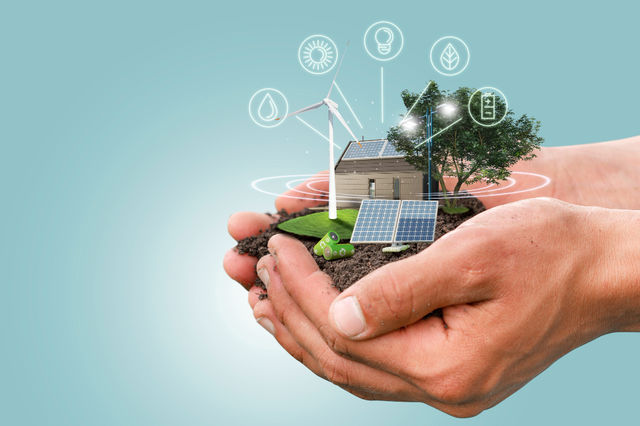Green energy, also known as renewable energy, refers to the types of energy produced from natural resources that are continuously replenished. These include sunlight, wind, rain, tides, waves, and geothermal heat. Green energy is a sustainable alternative to fossil fuels, as it contributes less to climate change, promotes energy independence, and has the potential for significant job creation.
The Power of the Sun: Solar Energy
Solar energy, derived from the radiant light and heat emitted by the sun, has emerged as a leading source of green energy in recent years. The utilization of solar power involves the conversion of sunlight into electricity using photovoltaic (PV) cells or the harnessing of solar thermal energy through concentrated solar power (CSP) systems. Solar energy offers several advantages, including its abundance, sustainability, and low environmental impact.
One of the key benefits of solar energy is its virtually unlimited supply. The sun provides an immense amount of energy that far surpasses global energy consumption. With advancements in technology, solar panels have become increasingly efficient, allowing for greater energy production even in areas with less sunlight. Moreover, solar energy is a renewable resource, meaning it can be harnessed indefinitely without depleting natural resources, making it an attractive alternative to fossil fuels.
Solar power also boasts a minimal environmental footprint. Unlike traditional energy sources such as coal or oil, solar energy production does not release greenhouse gases or other harmful pollutants into the atmosphere. This not only helps combat climate change but also improves air quality, reducing the health risks associated with pollution. Additionally, solar panels are silent and require little maintenance, making them suitable for various locations, including residential rooftops, commercial buildings, and large-scale solar farms.
Furthermore, the widespread adoption of solar energy has the potential to create economic opportunities and job growth. The solar industry has experienced significant growth in recent years, leading to the creation of numerous jobs in manufacturing, installation, and maintenance. Moreover, investing in solar energy infrastructure can contribute to energy independence, reducing reliance on imported fossil fuels and strengthening national security.
Is Wind Power the Answer to Our Energy Needs?
Wind power has emerged as a promising solution to meet our growing energy demands while reducing our reliance on fossil fuels. Harnessing the power of the wind, wind turbines generate electricity by converting kinetic energy into usable electrical energy. With its renewable and clean nature, wind power offers numerous benefits and has the potential to play a significant role in our transition to a sustainable energy future.
One of the key advantages of wind power is its abundant availability. Wind is a virtually limitless resource, as it is created by natural weather patterns. Wind turbines can be placed on land or offshore, taking advantage of strong wind currents and maximizing energy production. Additionally, advances in turbine technology have increased their efficiency, allowing for higher energy generation even at lower wind speeds.
Another advantage of wind power is its environmental friendliness. Wind energy production does not produce greenhouse gas emissions or air pollutants, making it a clean alternative to traditional energy sources. By reducing the reliance on fossil fuels, wind power helps mitigate climate change and improve air quality, leading to a healthier environment for both humans and wildlife.
In addition to its environmental benefits, wind power also presents economic opportunities. The wind industry has experienced significant growth, creating jobs in manufacturing, installation, and maintenance. Furthermore, wind power projects can provide economic benefits to local communities through lease agreements and tax revenues. This can stimulate local economies and contribute to regional development.
While wind power has great potential, it also faces certain challenges. The intermittent nature of wind requires the integration of energy storage systems or a diverse energy mix to ensure a stable and reliable electricity supply. Additionally, wind turbines can have visual and noise impacts, requiring careful planning and consideration in their placement.
The Untapped Potential of Tidal Energy
Tidal energy, also known as tidal power, is a form of renewable energy that harnesses the power of ocean tides to generate electricity. It utilizes the natural rise and fall of tides, which are caused by the gravitational forces of the moon and the sun. Despite its immense potential, tidal energy remains largely untapped, but recent advances in technology and growing interest in renewable energy sources have sparked renewed attention towards this promising alternative.
One of the main advantages of tidal energy is its predictability. Tides are highly predictable and follow a regular cycle, making it easier to forecast energy production. This reliability allows for better grid integration and efficient energy planning. Additionally, unlike solar or wind energy, tidal energy is not affected by weather conditions, providing a stable and consistent power source.
Tidal energy also has a high energy density, meaning that a relatively small area can generate a significant amount of electricity. Tidal power plants can be installed near coastal areas, taking advantage of strong tidal currents. These plants typically consist of underwater turbines that capture the kinetic energy of the moving water. As the tides ebb and flow, the turbines spin and generate electricity.
Moreover, tidal energy is a clean and sustainable source of power. It produces no greenhouse gas emissions or air pollutants, contributing to a cleaner environment and mitigating climate change. The installation of tidal power plants can also create artificial habitats for marine life, enhancing biodiversity and promoting ecological benefits.
Despite its potential, tidal energy faces some challenges. The high capital costs associated with the construction and maintenance of tidal power plants have hindered its widespread deployment. The harsh marine environment and the potential impacts on marine ecosystems require careful planning and environmental considerations.
Geothermal Energy: The Heat Beneath Our Feet
Geothermal energy is a renewable source of power that harnesses the natural heat stored within the Earth’s core. It utilizes the heat generated from the radioactive decay of minerals deep within the Earth, presenting a sustainable and abundant energy option. Geothermal energy has gained significant attention in recent years due to its potential to provide a reliable and clean source of electricity and heating.
One of the main advantages of geothermal energy is its constant availability. Unlike solar or wind energy, which are intermittent and dependent on weather conditions, geothermal energy is accessible 24/7. The Earth’s heat is a virtually limitless resource, providing a continuous and reliable source of power. This stability makes geothermal energy an attractive option for meeting the base load electricity demands of communities and industries.
Geothermal power plants extract the heat from geothermal reservoirs by drilling deep into the Earth’s crust. This hot water or steam is then used to power turbines, which generate electricity. Additionally, geothermal energy can be directly used for heating purposes, such as district heating systems or geothermal heat pumps for residential and commercial buildings.
Furthermore, geothermal energy has minimal environmental impacts. It emits very low levels of greenhouse gases and air pollutants, contributing to cleaner air and reduced carbon emissions. Geothermal power plants also have a small physical footprint, making them suitable for areas with limited available land. However, it is essential to carefully manage geothermal resources to prevent depletion and potential subsidence of the land.
Despite its advantages, the widespread use of geothermal energy faces some challenges. The cost of drilling and exploration can be relatively high, especially for deep geothermal resources. Additionally, geothermal energy is location-specific, as it requires specific geological conditions to be economically viable. However, advances in drilling technology and increased investments in research and development are helping to overcome these barriers and further unlock the potential of geothermal energy.
The transition to green energy is no longer a choice but a necessity for the survival of our planet. It is not only a viable solution to the environmental crisis but also a beneficial economic strategy. The future of energy lies in harnessing the immense potential of renewable resources and integrating them seamlessly into our daily lives.








